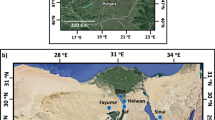Abstract
A comprehensive research has been conducted to explore the influence of sintering on the properties of fly ash aggregate containing clay binders (bentonite and kaolinite). Fly ash aggregate containing clay binders, have been subjected to various sintering temperatures at different durations of 700–1400 °C and 15–120 min, respectively. The variation in aggregate properties, viz strength, water absorption, density and shrinkage during sintering, have been determined and discussed. In addition to these, the uniformity of sintering and rate of water absorption of sintered aggregate were also determined. No significant changes in aggregate properties were observed for aggregate sintered up to 900 °C, due to the insufficient sintering temperature range. However, the aggregate properties substantially enhanced for temperature above 1000 °C, which is attributed to the activation of liquid phase sintering. For temperatures between 1000 and 1300 °C, the aggregate with bentonite shows significant increase in shrinkage (30 %), density (density ratio 0.70), higher ten percent fines value (TPFV) (6.13 tonne), reduction in porosity (35 %), and water absorption of 4 %. However, at 1400 °C, the aggregate properties degraded due to the decomposition of mineral phases in bentonite. For aggregates with kaolinite, highest TPFV of 8.5 tonne with lowest water absorption of 2 % have been observed at 1400 °C. The presence of a higher amount of interconnected pores for aggregates sintered between 700 and 1000 °C leads to a higher rate of water absorption and then reduces to 30 % for temperatures between 1200 and 1300 and 1200 to 1400 °C for bentonite and kaolinite aggregates, respectively. This reduction is due to the reduced interconnected pores. Duration of sintering has no impact on the aggregate properties for temperatures up to 800 and 1000 °C for aggregates with bentonite and kaolinite, respectively. However, between 1000 and 1400 °C, there has been considerable improvement in the aggregate properties for increasing duration up to 60 min. In comparison, during sintering, aggregates with bentonite possessed better properties for temperature less than 1000 °C, whereas aggregates with kaolinite exhibited superior properties between 1100 and 1400 °C.










Similar content being viewed by others
References
Bijen JM (1986) Manufacturing processes of artificial lightweight aggregates from fly ash. Int J Cem Compos Lightweight Concr 8:191–199
Mangialardi T (2001) Sintering of MSW fly ash for reuse as a concrete aggregate. J Hazard Mater B87:225–239
Cheeseman CR, Makinde A, Bethanis S (2005) Properties of lightweight aggregate produced by rapid sintering of incinerator bottom ash. Resour Conserv Recyl 43:147–162
Bethanis S, Cheeseman CR, Sollars CJ (2002) Properties and microstructure of sintered incinerator bottom ash. Ceram Int 28:881–886
Tay JH, Show KY, Hung SY (2002) Concrete aggregates made from sludge-marine clay mixes. J Mater Civil Eng ASCE 14:392–398
Ramamurthy K, Harikrishnan KI (2006) Influence of binders on properties of sintered fly ash aggregate. Cem Concr Compos 28:33–38
Nowok JW, Benson SA, Jones ML, Kalmanovitch DP (1990) Sintering behaviour and strength development in various coal ashes. Fuel 69:1020–1028
German RM (1996) Sintering theory and practice. Wiley, New York
Cheeseman CR, Sollars CJ, McEntee S (2003) Properties, microstructure and leaching of sintered sewage sludge ash. Resour Conserv Recyl 40:13–25
Swamy RN, Lambert GH (1981) The microstructure of Lytag aggregate. Int J Cem Compos Lightweight Concr 3:273–282
Wegen VGJL, Bijen JMJM (1985) Properties of concrete made with three types of artificial PFA coarse aggregates. Cem Concr Compos 7:159–167
Zhang MH, Gjorv OE (1990) Characteristics of lightweight aggregate for high strength concrete. ACI Mater J 88:150–158
Weber S, Reinhardt HW (1997) A new generation of high performance concrete: concrete with autogenous curing. Adv Cem Based Mater 6:59–68
Lo Y, Gao XF, Jeary AP (1999) Microstructure of pre-wetted aggregate on lightweight concrete. Build Environ 34:759–764
ASTM C 618-98 (1998) Standard specification for fly ash and raw or calcined natural pozzolan for use as a mineral admixture in portland cement concrete. Philadelphia
Manikandan R, Ramamurthy K (2007) Influence of fineness of fly ash on the aggregate pelletization process. Cem Concr Compos 29:456–464
Manikandan R, Ramamurthy K (2009) Swelling characteristics of bentonite on pelletization and properties of fly ash aggregates. J Mater Civil Eng ASCE 21:578–586
ASTM C 1202-97 (1997) Standard test method for electrical indication of concrete’s ability to resist chloride ion penetration. Philadelphia
ASTM E 122 (1972) Standard recommended practice for choice of sample size to estimate the average quality of a lot or process. Philadelphia
Neville AM (2000) Properties of concrete. Longman, London
BS 812-110 (1990) Methods for determination of aggregate crushing value. London
Mitchel JK (1993) Fundamental of soil behaviour, 2nd edn. Wiley, Canada
Arau jo EM, Melo TJA, Santana LNL, Neves GA, Ferreira HC, Lira HL, Carvalho LH, Avila MM Jr, Pontes MKG, Arau jo IS (2004) The influence of organo-bentonite clay on the processing and mechanical properties of nylon 6 and polystyrene composites. Mater Sci Eng 112:175–178
Ayari F, Srasra E, Trabelsi-Ayadi M (2005) Characterization of bentonitic clays and their use as adsorbent. Desalination 185:391–397
Grim RE (1962) Applied clay mineralogy. McGraw-Hill Book Company, New York
Balek V, Murat M (1996) The emanation thermal analysis of kaolinite clay minerals. Thermachim Acta 283:385–397
Frost RL, Horvath E, Mako E, Kristof J, Redey A (2003) Slow transformation of mechanically dehydroxylated kaolinite to kaolinite—an ages mechanochemically activated formamide-intercalated kaolinite study. Thermochim Acta 408:103–113
Author information
Authors and Affiliations
Corresponding author
Electronic supplementary material
Below is the link to the electronic supplementary material.
Rights and permissions
About this article
Cite this article
Manikandan, R., Ramamurthy, K. Physical characteristics of sintered fly ash aggregate containing clay binders. J Mater Cycles Waste Manag 14, 120–131 (2012). https://doi.org/10.1007/s10163-012-0045-1
Received:
Accepted:
Published:
Issue Date:
DOI: https://doi.org/10.1007/s10163-012-0045-1




